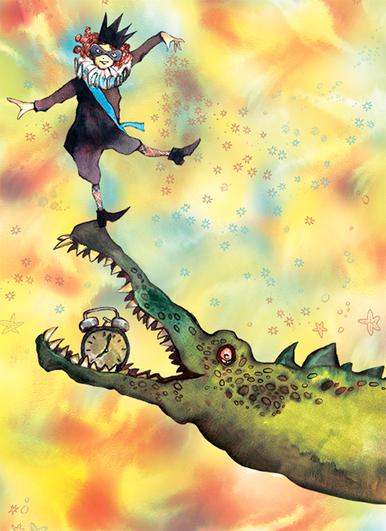Chopininana and Grand Pas from the ballet Paquita made the programme of one-act ballets, the premiere of which will be held on the 30th of November.
Absolutely different in spirit and wording, they nevertheless not only perfectly complement each other, but are also able to coexist in close logical unity. Grand Pas from Paquita, which has become one of the summits of the Russian Imperial ballet of Petipa’s era, demands a virtuoso technical brilliance, the perfect polish of each movement and the bravura of aristocratic execution. Chopiniana, a no less famous ballet, staged at the dawn of the 20th century, which perfectly reflects the spirit of the new age, is an example of extremely fine stylisation – the stylisation of airy romantic ballets which had preceded the time of Petipa. Not without reason, it is shown first in this programme, embodying the forerunner of Petipa’s ballets and that new which came to replace them. “Fokine’s creation is the finalisation of the style, the 20th century view of the era of Taglioni. La Sylphide and Chopiniana are the two points of a circle. A hundred years later the circle closed.” (Researcher of ballet history, Yuri Slonimsky).
“A Sylph, a winged hope, is flying into the romantic garden lit up by moonlight. She is followed by a young man. It was a dance in Taglioni’s style, the style of a long-forgotten time when poetry dominated ballet, when dancers raised on pointe not to demonstrate steel on the tips of their toes but to, by barely touching the ground, create with their dance an impression of lightness, something out of this place, fantastic. There were no pirouettes in that dance, no tricks”, as a renowned reformer of academic traditions, Mikhail Fokine reminisced about one of the most successful productions, also realised at the very beginning of his career as choreographer at the Mariinsky Theatre.
At the Bolshoi, Chopiniana was first “heard” of in 1932. Then the ballet was renewed several times, including the capital renewal of 1958. During the second half of the century, it never left the theatre’s repertoire for long. However, this season it returns to the stage after a ten-year break. To realise the new production, the Bolshoi invited Natalia Bolshakova and Vadim Gulyaev, who were outstanding dancers at the Kirov (Mariinsky) Theatre in the past and now no less renowned pedagogues, repetiteurs and keepers of the “spirit and letter” of the classical and neoclassical heritage.
Undoubtedly, Paquita would bear the test of our, the newest time, which is inclined to all sorts of melodramas, with honour. The heroine, a lady of aristocratic origin, who was kidnapped by bandits as a child, wanders with a gypsy camp around Spanish cities and towns, experiences various adventures and, in the end, finds her parents and a noble groom. However, time itself has conducted its own selection, having left out the plot with its pantomime development and spared only the dance.
It was the first (and one more “call-over” with Fokine’s ballet!) production by the young Marius Petipa on the Russian stage (1847, St Petersburg), which a year later followed his premiere at the Paris Opera, where Paquita saw the light of the ramp for the efforts of composer E.M. Deldevez and ballet master J. Mazilier. Soon after, a year later once again, the ballet was reproduced on the stage of the Moscow Bolshoi Theatre.
In 1881 at the Mariinsky Theatre, Paquita was given as a benefit performance of one of Petipa’s favourite ballerinas, Ekaterina Vazem. Not only did maestro rework the ballet significantly but added the final Grand Pas (and children’s Mazur) to the music by Minkus. This Grand Pas Classique, dedicated to the wedding of the main characters, together with the pas de trois from the first act and the already mentioned Mazur, is what has survived in the 20th century out of the whole large-scale performance. Grand Pas is an example of an extensive ensemble classical dance, which is well structured and gives the opportunity to show off one’s virtuoso skills and get into the swing of competing with each other to almost all leading soloists, amongst which is the one who performs the part of Paquita herself, and she has the chance to display a completely unattainable level of skill and ballerina’s charisma. This choreographic artwork is often called a troupe’s parade portrait, which indeed must contain an array of sparkling talents to claim its fulfilment.
Yuri Burlaka was introduced to Paquita in his early youth – pas de trois from Paquita became his debut at the Russian Ballet Theatre, which he joined straight after graduation from the Academy of Choreography. Later, when he had already been actively engaged in research in the field of old choreography and ballet music, he took part in the publication of the clavier of the surviving musical numbers of the Paquita ballet and the recording of Petipa's choreographic text. The Bolshoi is receiving Petipa’s masterpiece from the hands of the connoisseur for a second time. Originally, Yuri Burlaka staged Grand Pas from the ballet Paquita in 2008 and it was his first staging at the Bolshoi following the announcement of his appointment as Artistic Director of the Bolshoi Ballet. It was shown for the last time in 2010. The time for a new version has finally arrived.


